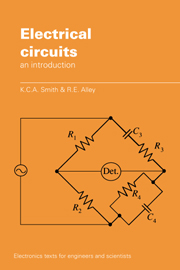Book contents
- Frontmatter
- Contents
- Program listings
- Preface
- 1 Basic concepts, units, and laws of circuit theory
- 2 Theorems and techniques of linear circuit analysis
- 3 Alternating current circuits
- 4 Power and transformers in single-phase circuits
- 5 Three-phase alternating current circuits
- 6 Transient and steady-state analysis
- 7 Non-linear circuit analysis
- 8 Two-port networks
- Appendices
- Bibliography
- Answers to problems
- Index
5 - Three-phase alternating current circuits
Published online by Cambridge University Press: 05 June 2012
- Frontmatter
- Contents
- Program listings
- Preface
- 1 Basic concepts, units, and laws of circuit theory
- 2 Theorems and techniques of linear circuit analysis
- 3 Alternating current circuits
- 4 Power and transformers in single-phase circuits
- 5 Three-phase alternating current circuits
- 6 Transient and steady-state analysis
- 7 Non-linear circuit analysis
- 8 Two-port networks
- Appendices
- Bibliography
- Answers to problems
- Index
Summary
Introduction
In chapters 3 and 4, circuits were considered in which the alternating energy sources possess the same frequency but, in general, different voltages and internal impedances, and arbitrary phase relationships. Each voltage source in such circuits may be thought of as being generated by the interaction between a stationary coil of wire and a properly shaped rotating magnetic field, as shown schematically in fig. 5.1 (a). Now, suppose that instead of a single coil (generally referred to as a winding) there are n windings symmetrically disposed on the stator of the machine. If the windings are identical, their impedances are equal and the amplitudes of their induced voltages are equal. The voltages will all be of the same frequency, determined by the angular speed of the rotating magnet, and the phase relations among them will be fixed. The phase difference between the voltages of two successive windings will be 2π/n radians or 360/n degrees. A machine constructed in this fashion is an n-phase generator.
The majority of power systems throughout the world utilize the three-phase generator, shown schematically in fig. 5.1 (b). In fig. 5.2 are shown (a) a phasor diagram for the three-phase generator, and (b) graphs of voltage v. time for the three phases. The three voltages differ in phase by 360/3 = 120°.
The generators in a power system are connected to a series of step-up and step-down transformers that provide voltage levels appropriate for the efficient transmission, distribution and consumption of the power generated.
- Type
- Chapter
- Information
- Electrical CircuitsAn Introduction, pp. 231 - 279Publisher: Cambridge University PressPrint publication year: 1992

